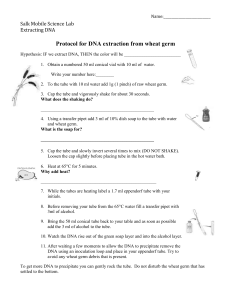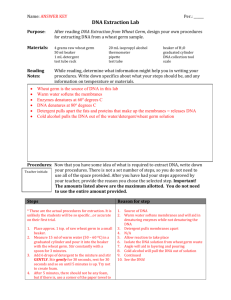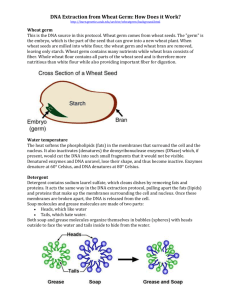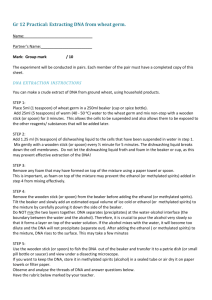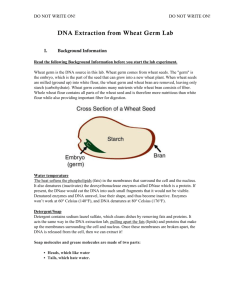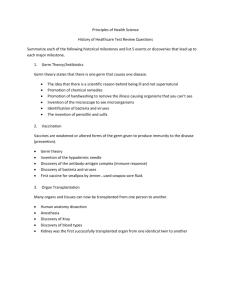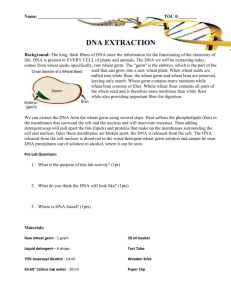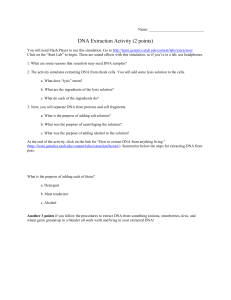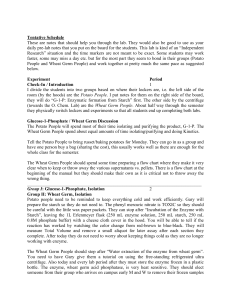15. DNA Lesson Plan - Materials Research Laboratory at UCSB
advertisement
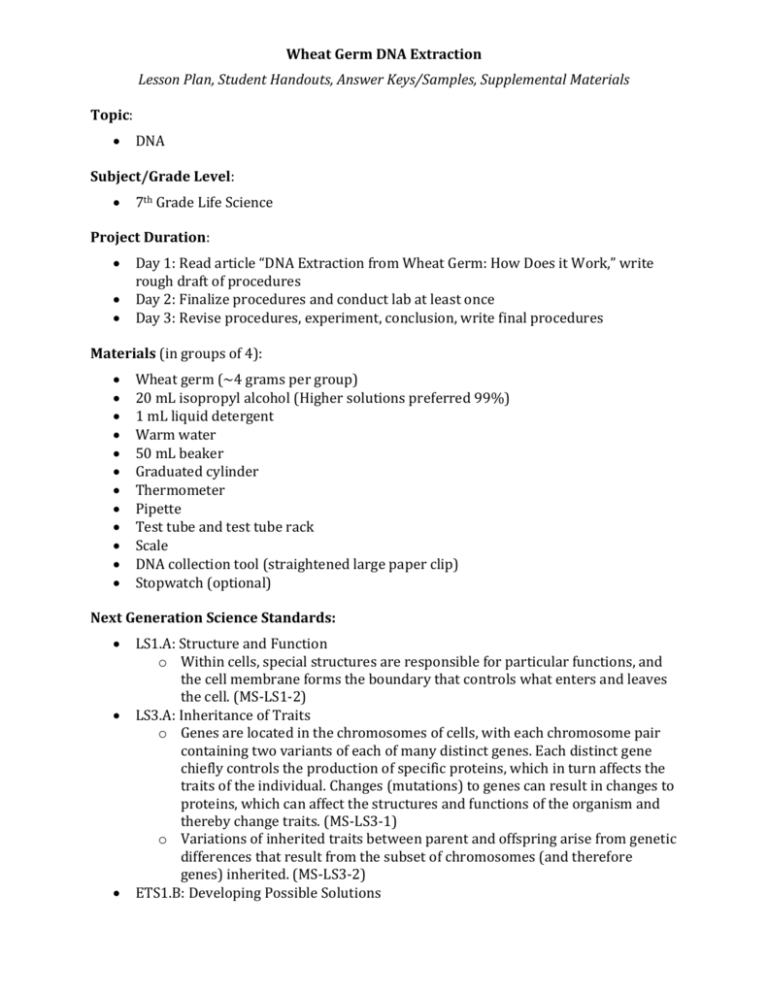
Wheat Germ DNA Extraction Lesson Plan, Student Handouts, Answer Keys/Samples, Supplemental Materials Topic: DNA Subject/Grade Level: 7th Grade Life Science Project Duration: Day 1: Read article “DNA Extraction from Wheat Germ: How Does it Work,” write rough draft of procedures Day 2: Finalize procedures and conduct lab at least once Day 3: Revise procedures, experiment, conclusion, write final procedures Materials (in groups of 4): Wheat germ (~4 grams per group) 20 mL isopropyl alcohol (Higher solutions preferred 99%) 1 mL liquid detergent Warm water 50 mL beaker Graduated cylinder Thermometer Pipette Test tube and test tube rack Scale DNA collection tool (straightened large paper clip) Stopwatch (optional) Next Generation Science Standards: LS1.A: Structure and Function o Within cells, special structures are responsible for particular functions, and the cell membrane forms the boundary that controls what enters and leaves the cell. (MS-LS1-2) LS3.A: Inheritance of Traits o Genes are located in the chromosomes of cells, with each chromosome pair containing two variants of each of many distinct genes. Each distinct gene chiefly controls the production of specific proteins, which in turn affects the traits of the individual. Changes (mutations) to genes can result in changes to proteins, which can affect the structures and functions of the organism and thereby change traits. (MS-LS3-1) o Variations of inherited traits between parent and offspring arise from genetic differences that result from the subset of chromosomes (and therefore genes) inherited. (MS-LS3-2) ETS1.B: Developing Possible Solutions o A solution needs to be tested, and then modified on the basis of the test results, in order to improve it. (secondary to MS-PS1-6) ETS1.C: Optimizing the Design Solution o Although one design may not perform the best across all tests, identifying the characteristics of the design that performed the best in each test can provide useful information for the redesign process—that is, some of the characteristics may be incorporated into the new design. (secondary to MSPS1-6) o The iterative process of testing the most promising solutions and modifying what is proposed on the basis of the test results leads to greater refinement and ultimately to an optimal solution. (secondary to MS-PS1-6) Common Core State Standards: Reading: o Cite specific textual evidence to support analysis of science and technical texts. o Follow precisely a multistep procedure when carrying out experiments, taking measurements, or performing technical tasks. o Integrate quantitative or technical information expressed in words in a text with a version of that information expressed visually (e.g., in a flowchart, diagram, model, graph, or table). Writing o Write informative/explanatory texts, including the narration of historical events, scientific procedures/ experiments, or technical processes. Learning Objectives: Students will be able to design a procedure for extracting DNA from wheat germ given an informational text on the components of the wheat plant, and the function of the other chemicals used in the process. Students will be able to write procedures for extracting DNA. Students will be able to explain the role of heat, detergent and alcohol in the extraction process. Background Information: Wheat Germ: The DNA source in this protocol. Wheat germ comes from wheat seeds. It is the embryo. Heat: Softens the membranes that surround the cell and nucleus. It also denatures the enzymes that would cut DNA into small fragments rendering it invisible. Detergent: Pulls apart the membranes allowing DNA to be released from the cell. Alcohol: Separates the DNA from the other cell components left in the water. Cold alcohol precipices DNA more quickly. Although the goal of this inquiry lab is for students to experience failure, modify their protocol, and retest, below is an actual set of procedures for how to successfully extract DNA on the first round. I would guide students to the fact that they have a “teaspoon” (hint hint) at their station for the wheat germ and they have a dropper for the soap (so it will be on the order of drops). Remind them that you have “warm water” ready for them. Ideally they will pull the info from the background reading that it needs to be between 50o-60o. 1. Place 1 tsp. of raw wheat germ in a small beaker. 2. Get warm water from your teacher. The water temperature needs to be between 50 – 60 ºC. If it’s not the right temperature return it. 3. Measure 15 ml of water in a graduated cylinder and pour it into the beaker with the wheat germ. Stir constantly with a spoon for 3 minutes. 4. Add 6 drops of detergent to the mixture and stir GENTLY. Stir gently for 30 seconds, rest for 30 seconds and so on until 5 minutes is up. Try not to create foam. 5. After 5 minutes, there should not be any foam, but if there is, use a corner of the paper towel to carefully absorb the foam. 6. Allow the beaker to sit for 30 seconds. 7. Pour the liquid slowly into the test tube, leaving the wheat germ in the beaker. 8. Place the test tube in the test tube rack at an angle, as demonstrated. 9. Measure 8 ml of cold isopropyl alcohol in the graduated cylinder. 10. Leaving the test tube at an angle in the rack, pour the alcohol VERY SLOWLY into the test tube. The alcohol should float on top of the water and not mix with it. 11. Let the test tube sit for at least 5 minutes. Then put the DNA collection tool into the test tube and draw out the DNA. More DNA will form with time. Instructional Design: Day 1: Hand out the “DNA Extraction Lab” paper. As a class you can review the “Purpose,” “Materials,” and “Reading Notes” sections. Next, hand out the “DNA Extraction from Wheat Germ: How Does it Work?” reading. Have students read sections aloud to the class. While listening, they should be writing down any information they feel would be helpful in designing their procedures. You may also want to clarify or give examples during the reading of this page. After reading through the document, have them make a first attempt at writing the procedures for the extraction. (Hint: The reading goes in order that their procedures should, but leaves out exact amounts and temperatures.) It is recommended that they do this in pairs or small groups. Next to each step, they must justify their reasoning with evidence from the reading. Day 2: Have the students either finish up their procedures/reasoning or have them approved. It is recommended that you read them just to make sure there are no major issues with quantity or safety concerns. Once they have had them approved and initialed, they may pick up their materials and begin their first trial. It is likely that they will not be successful on the first trial. When they have exhausted their time with trial 1, they should edit their procedures. They can talk with other groups, and try to find the source of their errors. Once you have approved their edits, they can try again, time permitting. Day 3: One final day for experimenting. Even if a group is successful, they can try to improve their procedures to obtain better results. Allow time to answer the “Questions” section in class, and discuss. Question 4 should provide a group opportunity for students to engage in relevant dialogue about the process of experimentation/research. For homework (or in class if time permits) the students should complete the “DNA Extraction Lab: Final Procedures” write up based on their best trial. Assessment: Students will be assessed on the following pieces: Initial Procedures with reasoning from text Conclusion questions answered in complete sentences
